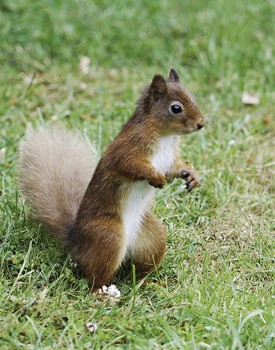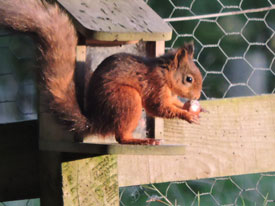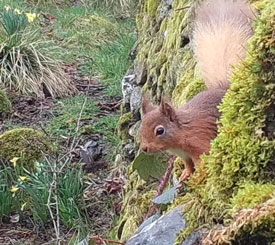 Good news has been received over the summer – the European Commission have finally published a list of 37 species to which the EU Invasive Alien Species Regulation will apply; the grey squirrel is on the list! The EU Regulation requires Member States to put in place surveillance and rapid response mechanisms and to develop management action plans to prevent the introduction, or manage the spread of, invasive non-native species. Although the British public have voted to leave the European Union, this process will take some years and therefore will not affect the implementation of the IAS regulation. Unlike England and Scotland, Wales does not currently have a policy on the control of grey squirrels. We anticipate that this move will boost the momentum to produce a Grey Squirrel Policy for Wales. Watch this space!
Good news has been received over the summer – the European Commission have finally published a list of 37 species to which the EU Invasive Alien Species Regulation will apply; the grey squirrel is on the list! The EU Regulation requires Member States to put in place surveillance and rapid response mechanisms and to develop management action plans to prevent the introduction, or manage the spread of, invasive non-native species. Although the British public have voted to leave the European Union, this process will take some years and therefore will not affect the implementation of the IAS regulation. Unlike England and Scotland, Wales does not currently have a policy on the control of grey squirrels. We anticipate that this move will boost the momentum to produce a Grey Squirrel Policy for Wales. Watch this space!
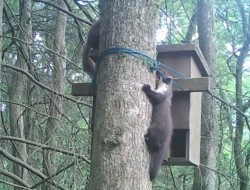 Just what impact are those pine martens having on our squirrels? Find out how Chris Harris is playing his part in the Pine Marten Restoration Project and get the latest news from our trail cams. A Vincent Wildlife Trust (VWT) remote camera has captured some amazing pine marten footage of a kit trying to take its first steps out of the box and then falling. Mum comes to the rescue, but is mid-lunch when it happens and she has a grey squirrel in her mouth! Mum drops the squirrel and rescues her wayward kit, carrying it back up the tree before returning for her squirrel.
Just what impact are those pine martens having on our squirrels? Find out how Chris Harris is playing his part in the Pine Marten Restoration Project and get the latest news from our trail cams. A Vincent Wildlife Trust (VWT) remote camera has captured some amazing pine marten footage of a kit trying to take its first steps out of the box and then falling. Mum comes to the rescue, but is mid-lunch when it happens and she has a grey squirrel in her mouth! Mum drops the squirrel and rescues her wayward kit, carrying it back up the tree before returning for her squirrel.
This fabulous clip>> demonstrates that grey squirrel control might be one positive outcome of the VWT’s Pine Marten Restoration Project. Read more>>


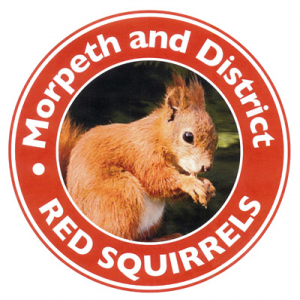 2016 has proved to be quite interesting. The early months saw greatly reduced grey sightings and in fact all sightings both red and grey were down. This was being reported across the board by many local groups. We then had quite sudden surges of grey activity in areas, and our enormous thanks as usual go to our grey control team who dealt with these. In the Shadfen area, where we have had very little grey activity, we have suddenly experienced a grey invasion and 17 were removed in July alone. This grey control is as always absolutely essential as there are a colony of reds in this area who have to be protected. There have been a family of reds visiting feeders which was lovely to see, but 12 greys were also removed from these feeders too. We had a heart stopping moment when one of the juvenile reds appeared to be quite sluggish and was not eating well and we suspected squirrel pox. This little red was caught and taken to a local vets where sadly it had to be euthanised. Fingers crossed…so far this looks like the one and only case. Swift action to remove incoming greys and also sadly removing this poorly red quickly, hopefully has protected the others.
2016 has proved to be quite interesting. The early months saw greatly reduced grey sightings and in fact all sightings both red and grey were down. This was being reported across the board by many local groups. We then had quite sudden surges of grey activity in areas, and our enormous thanks as usual go to our grey control team who dealt with these. In the Shadfen area, where we have had very little grey activity, we have suddenly experienced a grey invasion and 17 were removed in July alone. This grey control is as always absolutely essential as there are a colony of reds in this area who have to be protected. There have been a family of reds visiting feeders which was lovely to see, but 12 greys were also removed from these feeders too. We had a heart stopping moment when one of the juvenile reds appeared to be quite sluggish and was not eating well and we suspected squirrel pox. This little red was caught and taken to a local vets where sadly it had to be euthanised. Fingers crossed…so far this looks like the one and only case. Swift action to remove incoming greys and also sadly removing this poorly red quickly, hopefully has protected the others. 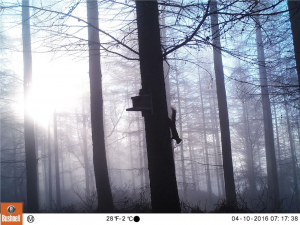

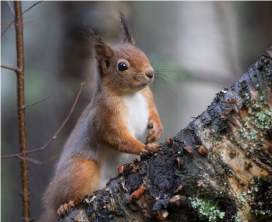 Work has of course continued as well as possible with the rangers and volunteers monitoring the various areas, carrying out grey control and dealing with the challenges at hand. Unfortunately the pox virus has once again reared its ugly head in some areas having a varying degree of impact amongst the red squirrel population. In most cases, with the various actions taken by both the rangers and volunteers, the pox was soon contained with healthy reds thankfully still being seen.
Work has of course continued as well as possible with the rangers and volunteers monitoring the various areas, carrying out grey control and dealing with the challenges at hand. Unfortunately the pox virus has once again reared its ugly head in some areas having a varying degree of impact amongst the red squirrel population. In most cases, with the various actions taken by both the rangers and volunteers, the pox was soon contained with healthy reds thankfully still being seen. 

